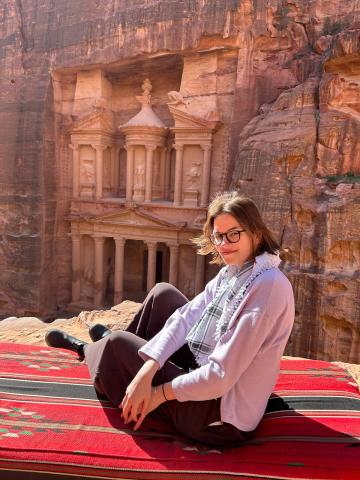
2022 Aigrain Grant Recipient - Mariam Hossaini (GSMS'23)
Congratulations Miriam!
My experience with the Aigrain grant truly speaks to the endless possibilities that this scholarship offers students. While my summer did not go according to plan, the Aigrain grant was flexible enough to accommodate my plans as they changed over the semester.
When I was first awarded the grant, I had plans to travel to Cairo as part of a research team studying informal sabils with professor Tessa Farmer. Sabils are a type of charitable water fountain. In their formal state they reside in large, Islamic buildings, while in their informal, they may take shape as clay pots or Coleman water jugs shared with community members. Professor Farmer’s research focused on informal sabils found in Cairo’s settlements, but when our team ended up working with Athar Lina, a participatory conservation initiative in Cairo, the course of our research changed slightly. Athar Lina “aims to establish modalities of citizen participation in heritage conservation based on an understanding of the monument as a resource, not a burden”. Run by the Built Environment Collective|Megawra, a twin organization including an NGO and an architecture firm, they use community-engaged methods and co-creation techniques to regenerate the Historic Cairo community. Our research group was going to assist with Athar Lina’s research into how to create sustainable small income-generating activities and urban gardening with the community around the historic sabil in Khalifa. While this steers away from the informal sabils Tessa Farmer was studying, it would have been interesting to conduct ethnographic research to understand the community’s relationship with the historic sabil in the heart of the neighborhood. We held bi-weekly meetings leading up to the trip, going over the history of Cairo, and the current events, and doing ethnographic research workshops.
Shortly after joining Athar Lina’s team, Professor Farmer had to make the tough call to cancel the trip due to possible political instability in Cairo. The war in Ukraine had rippling effects in Egypt, particularly on the wheat supplies. Because rising bread prices have led to political instability many times before, we had to err on the side of caution. This was an extremely stressful time for me since I had already accepted the grant and planned my summer around the travel plans. This pushed me to pursue and find new ways to use my grant meaningfully, even if I had to make these opportunities myself.
As an architecture major, I did not want to miss the opportunity to work with Athar Lina, an organization whose mission statement resonates so clearly with my architectural and career goals. I reached out to Dr. May al-Ibrashy, the Athar Lina Initiative Coordinator, and began to form a professional connection outside of the research group. On her visit to UVA, she was kind enough to meet with me and Tessa Farmer to discuss the possibility of working for their organization in some capacity. Since the cancellation was a preemptive measure, and the size of our research group made us a larger target, Professor Farmer, Dr. May al-Ibrashy, and I did entertain the idea of me traveling to Cairo alone to work with Athar Lina over the summer. While we sent numerous emails back and forth to coordinate my possible travels, Professor Farmer and I began to discuss alternate uses for the grant money. These alternative plans revolved around doing virtual research and archival work for her book and gauging what a virtual internship with Athar Lina could look like.
After numerous conversations, IRO filings, and countless emails, I concluded that traveling alone, abroad for the first time, with only a year and a half of Arabic under my belt and no professor supervision, may not be in my best interest. That being said, Dr. May al-Ibrashy welcomed me onto her team as a summer virtual intern. Even virtually, this was an opportunity of a lifetime. I was put on a team working on the regeneration of Historic Cairo’s Al-Khalifa Market, a redesign-focused project aimed to reinvigorate a dilapidated cultural hub of Al-Khalifa neighborhood. I worked closely with two Megawra employees, the architecture firm, to compile a report of their work thus far, and create diagrams that would be included in the file report. We met in the morning, once a week, to present updates from my work and get my next assignments. While the beginning of my internship consisted of compiling all of their proposals and history into a single report, I was able to finally offer my real design knowledge when they asked for my help with unique diagrams for the report. I got to analyze the different facets of ethnographic research and site analysis and create new ways of visualizing the data.
Because of their small and non-profit status, a paid internship with someone halfway across the world was not within their budget, but having the Aigrain Grant made it possible for me to work with them. I was so passionate about their mission that I eventually accepted the opportunity to continue working with them through the following Fall semester. While I had to take a step back for my final semester, we did agree to keep in touch following my graduation. As a student on financial aid, looking for work in the non-profit field, finding work experience while also making ends meet has been a challenge – having a grant like this made a world of difference. Not only did I get an amazing summer internship, but I found a job for the semester and even a professional connection for my post-graduate career. Without the grant, I wouldn’t have been pushed to find alternatives after the cancellation of the trip, nor would I have had the ability to put in as many hours without the money from the grant. I am so happy for all that it has made possible for me.
